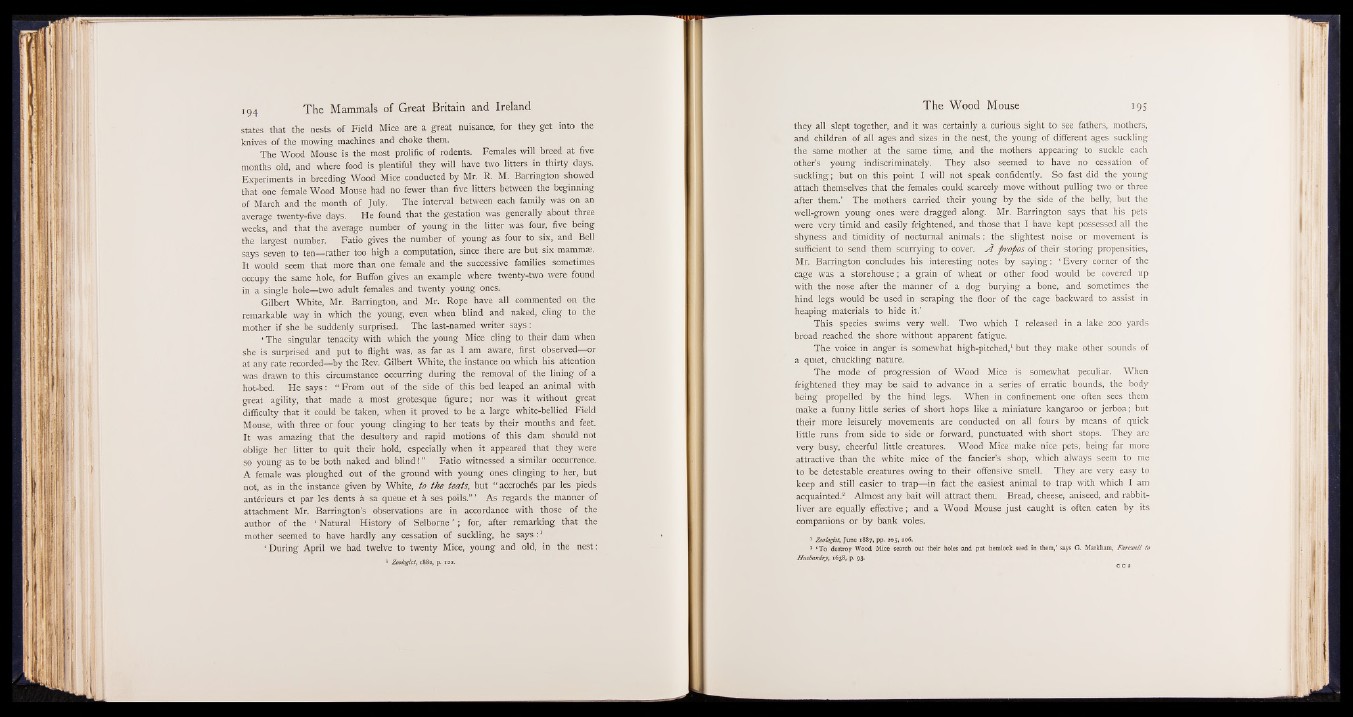
states that the nests of Field Mice are a great nuisance, for they get into the
knives of the mowing machines and choke them.
The Wood Mouse is the most prolific of rodents. Females will breed at five
months, old} and where food is plentiful they will have two litters in thirty days.
Experiments in breeding Wood Mice conducted by Mr. R. M. Barringtpn showed
that one female Wood Mouse had no fewer than five litters between the beginning
of March and the month of July. The interval between each family was on an
average twenty-five days. He found that the gestation was generally about three
weeks, and that the average number of young in the litter was four, five being
the largest number. Fatio gives the number of young as four to six, and Bell
says seven to ten—rather too high a computation, since there are but six mammae.
It would seem that more than one female and the successive families sometimes
occupy the same hole, for Buffon gives an example where twenty-two were, found
in a single hole—two adult females and twenty young ones.
Gilbert White, Mr. Barrington, and Mr. Rope have all commented on the
remarkable way in which the young, even when blind and naked, cling to the
mother if she be suddenly surprised. The last-named writer says :
‘ The singular tenacity with which the young Mice cling to their dam when
she is surprised and put to flight was, as far as I am aware, first observed or
at any rate recorded—by the Rev. Gilbert White, the instance on which his attention
was drawn to this circumstance occurring during the removal of the lining of a
hot-bed. He says : “ From out of the side of this bed leaped an animal with
great agility, that made a most grotesque figure; nor was it without great
difficulty that it could be taken, when it proved to be a large white-bellied Field
Mouse, with three or four young clinging to her teats by their mouths and feet.
It was amazing that the desultory and rapid motions of this dam should not
oblige her litter to quit their hold, especially when it appeared that they were
so young as to be both naked and blind ! ” Fatio witnessed a similar occurrence.
A female was ploughed out of the ground with young ones clinging to her, but
not, as in the instance given by White, to the teats, but “ accrochés par les pieds
antérieurs et par les dents à sa queue et à ses poils.” ’ As regards the manner of
attachment Mr. Barrington’s observations are in accordance with those of the
author of the ‘ Natural History of Selborne ’ ; for, after remarking that the
mother seemed to have hardly any cessation of suckling, he s a y s :1 <
‘ During April we had twelve to twenty Mice, young and old, in the nest :
Zoologist, 1882, p.
they all slept together, and it was certainly a curious sight to see fathers, mothers,
and children of all ages and sizes in the nest, the young of different ages suckling
the same mother at the same time, and the mothers appearing to suckle each
other’s young indiscriminately. They also seemed to have no cessation of
suckling; but on this point I will not speak confidently. So fast did the young
attach themselves that the females could scarcely move without pulling two or three
after them.’ The mothers carried their young by the side of the belly, but the
well-grown young ones were dragged along. Mr. Barrington says that his pets
were very timid and easily frightened, and those that I have kept possessed all the
shyness and timidity of nocturnal animals : the slightest noise or movement is
sufficient to send them scurrying to cover. A ftropos of their storing propensities,
Mr. Barrington concludes his interesting notes by saying: ‘ Every corner of the
cage was a storehouse; a grain of wheat or other food would be covered up
with the nose after the manner of a dog burying a bone, and sometimes the
hind legs would be used in scraping the floor of the cage backward to assist in
heaping materials to hide it.’
This species swims very well. Two which I released in a lake 200 yards
broad reached the shore without apparent fatigue.
The voice in anger is somewhat high-pitched,1 but they make other sounds of
a quiet, chuckling nature.
The mode of progression of Wood Mice is somewhat peculiar. When
frightened they may be said to advance in a series of erratic bounds, the body
being propelled by the hind legs. When in confinement one often sees them
make a funny little series of short hops like a miniature kangaroo or jerboa; but
their more leisurely movements are conducted on all fours by means of quick
little runs from side to side or forward, punctuated with short stops. They are
very busy, cheerful little creatures. Wood Mice make nice pets, being far more
attractive than the white mice of the fancier’s shop, which always seem to me
to be detestable creatures owing to their offensive smell. They are very easy to
keep and still easier to trap—in fact the easiest animal to trap with which I am
acquainted.2 Almost any bait will attract them. Bread, cheese, aniseed, and rabbit-
liver are equally effective; and a Wood Mouse just caught is often eaten by its
companions or by bank voles.
1 Zoologist, June 1887, pp. 205, 206.
2 ‘To destroy Wood Mice search out their holes and put hemlock seed in them,’ says G. Markham, Farewell to
Husbandry, 1638, p. 93.